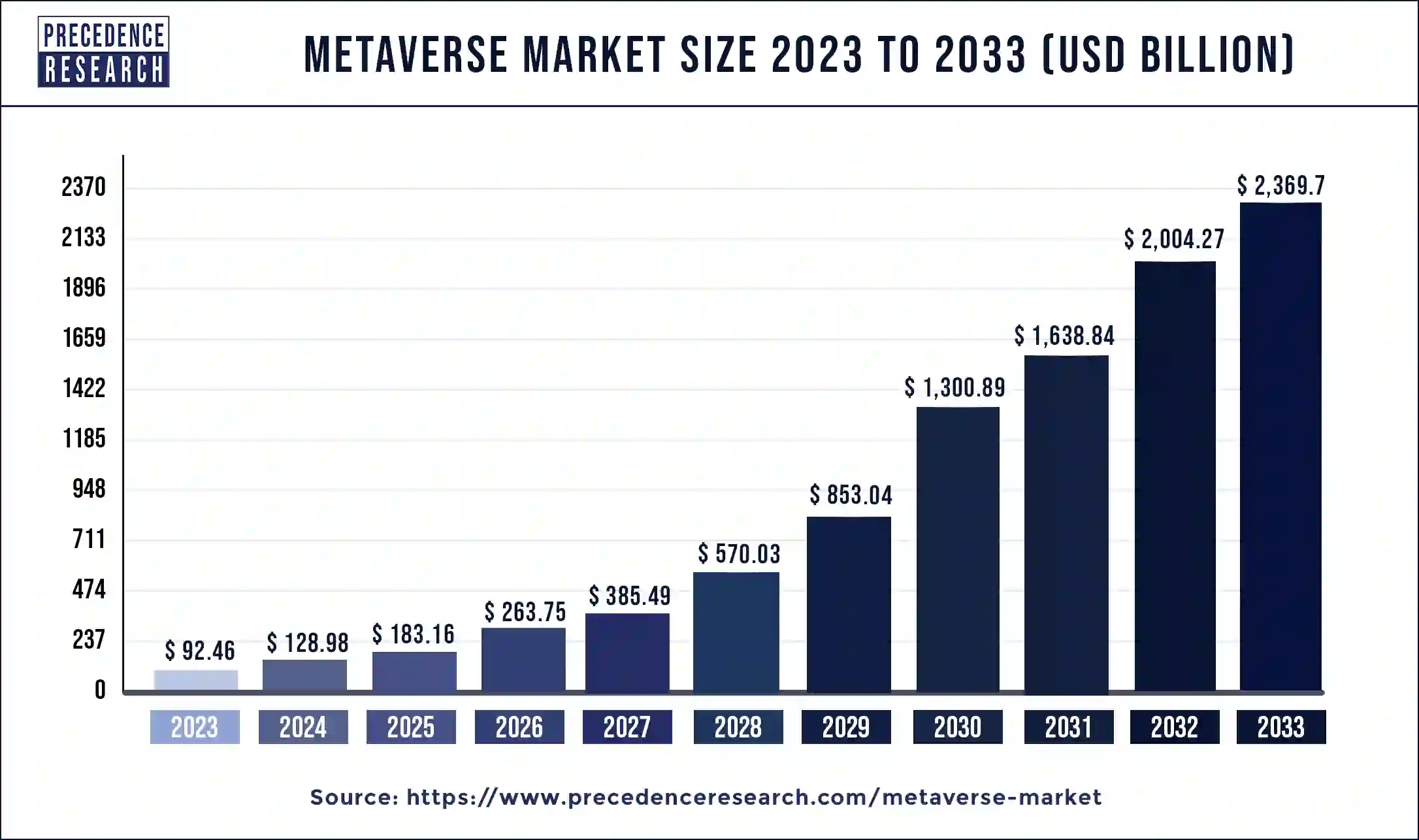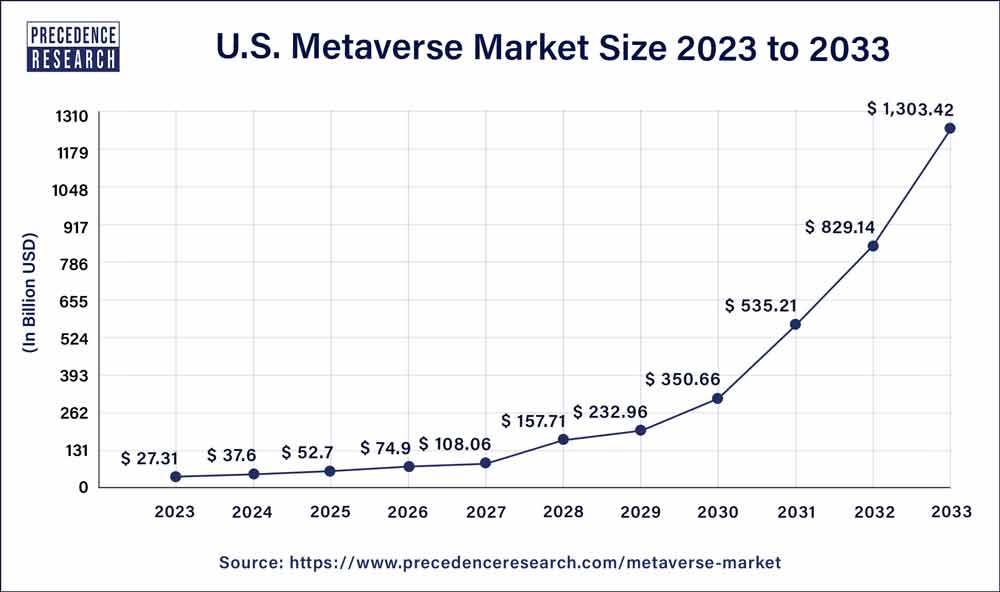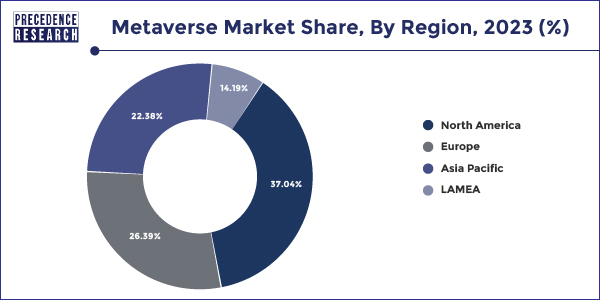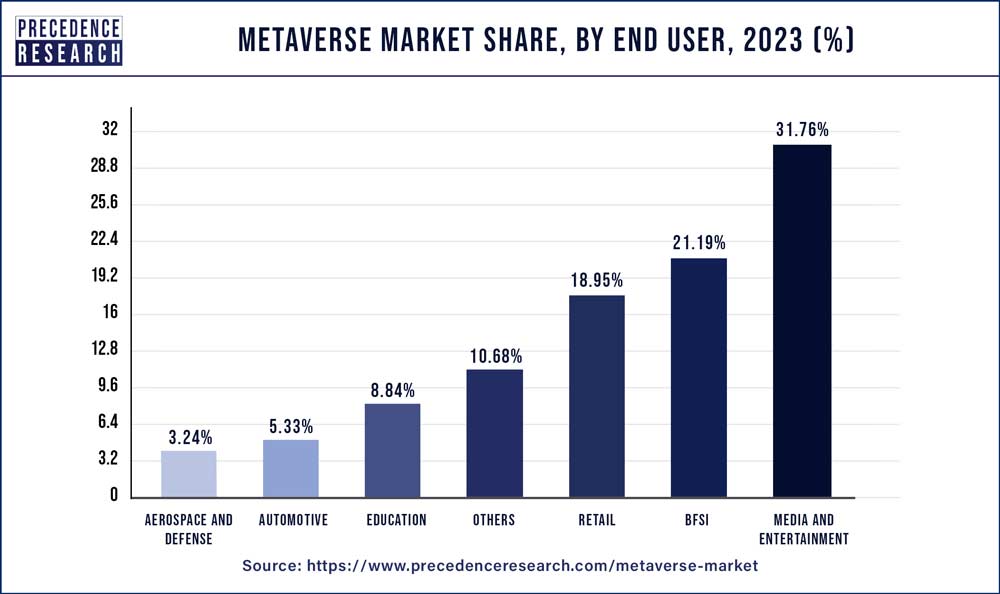June 2025
The global metaverse market size was valued at USD 92.46 billion in 2023 and it is estimated to surpass around USD 2,369.70 billion by 2033 with a registered CAGR of 38.31% during the forecast period 2024 to 2033.

The U.S. metaverse market size was valued at USD 27.31 billion in 2023 and is anticipated to reach around USD 1,303.42 billion by 2033, poised to grow at a CAGR of 48.3% from 2024 to 2033.

The North American has garnered a revenue share of around 37.04% in 2023. Due to the presence of many major companies which are situated in the North American market, the market is expected to see great growth.
Europe
Europe accounted second among all the regions in the metaverse market. The leading country in the region with respect to metaverse is UK which is followed by Germany and France respectively. The existence of companies such as Engine Creative, Blippar, Inde, and Holition that are involved actively in AR/VR sector is likely to fuel the metaverse market growth in the region. The virtual change in the UK is likely to fuel the growth in the country, the country is becoming a hotbed for Augmented Reality devices. The demand with respect to metaverse is likely to increase in the region, particularly from the gaming sector, as UK has one of the biggest video gaming sectors in the globe.
Leaving aside the reality that investing in Europe has its plus sides, which includes access to top universities, good-quality talent, and a big consumer market. Of all the services which could be made accessible in the metaverse, British are most expected to use it for shopping online. Consumers also anticipate to see the brands from which they shop in virtual worlds. Although the metaverse may appear a long way off, but Britishers are most likely to use it in shopping habits in the coming years and that businesses need to be on top of emerging technology.

Asia Pacific
The Asia Pacific region is poised to reach at a CAGR over the forecast period. The various academic and research centers which are present in this region are working in order to explore the other potentials of the metals market theater there shall be or rapid and attributable growth in the Asia Pacific region. Due to steady economic developments and increase reduction of the digitization across countries like India China and Japan the market is expected to grow during the forecast period. Technological advancements are favored by the presence of various tech giants, government departments and startups in this region. The presence of robust industrial environment, high commercial value and the technological revolution in the Asia Pacific market relating to the social networking, entertainment, digitization trend, education and gaming are the reasons why the market is expected to grow.
LAMEA
Latin America & Middle East and Africa is expected to hold a significant CAGR in the forecast period. Brazil is the leader here followed by Mexico and South Africa. Participation is becoming increasingly popular with respect to metaverse in the LAMEA countries. Regulators must also achieve an efficient governance structure to form transparency, trust, and accountability around this paradigm-operative technology. The pandemic made digital investments even more important, as everyday activities from schooling to shopping now feature a substantial online component which is here to stay.
Realising both the challenges and the opportunities, governments across the region have placed virtual transformation at the focus of their social development and economic plans. Moreover, South Africa’s non-fungible tokens (NFT) and metaverse market is likely to gain traction this year, as more companies dabble locally with immersive technologies to provide revenue and operational improvements. Metaverse and the NFTs are going to bolster, especially in the local entertainment and art areas, in the region.
The metaverse is a smooth convergence of the digital and physical lives, creating a virtual, unified community where people can play, work, transact, socialize, and relax. The metaverse is still in its early evolution, and there is no such definite meaning to which people can turn. Ideas of what the metaverse currently is and could be, still, are looming. A major point is that there is no one digital world but various worlds, which are shaping to enable people to extend and deepen social interactions virtually. This is accomplished by adding an enveloping, 3D layers to the web, and creating more natural and authentic user experiences. The metaverse even has the assurance of augmenting accessibility from the home, democratizing access to key services, goods, and experiences and breaking down boundaries. The metaverse has the ability to impact everything from customer experience to employee engagement, community building, product innovation, and omnichannel marketing and sales. Examining its effect potentially should be a factor for strategic discussions, with leaders intensifying their analysis of how this metaverse could fuel this virtual world within the coming years.
A rising number of operators in mobile have set out on their path for metaverse, including Verizon, KDDI, AT&T, and SKT. There are various ways that these operators can participate in the development of metaverse and capture value, by leveraging the advanced possibilities of 5G networks or non-infrastructure circumstances such as utilising present virtual identity efforts to create incremental revenue from these services.
Appropriate policymaking will be required to turn these ambitions into reality while also keeping safe the users from any abuse. Regulatory frameworks will be required to augment mobile operators’ steady investments in deployments of 5G network, ensure impartial competition and diminish concerns related to safety, data privacy, and security. Furthermore, planning for the metaverse impact on their networks, these operators should drift now to recognize potential opportunities, work together with content creators, partner with companies who make hardware to make compelling propositions for enterprise and consumer markets.
Metaverse development is often linked to the advanced virtual reality technology as there is an increasing demand for immersion. Information privacy, user addiction, and user safety are the various concerns with metaverse. Access points for the metaverse includes general-purpose computers and smartphones, augmented reality, mixed reality, and virtual reality.
Dependency on the VR technology has limited the growth of metaverse and limited the development and wide-scale adoption. There are many limitations of portable hardware and there is need to balance cost and design that has caused a lack of high-quality graphics in this field and lack of mobility.
The Metaverse is a collection of interconnected online realm which offers the interactions between the augmented, physical and virtual reality. Users are able to interact with their friends, work, travel, purchase goods and services, and attend different events. As more and more people have started working and going to school remotely, there has been an increased demand for ways in order to make online interaction more lifelike in the future. As a result, rising focus on converging digital and physical worlds with the use of Internet is driving the metaverse market growth. There is a growth of this market due to crypto gaming. Investments are increasing as the number of investors is contributing to this growth. The concept of play to on models it's followed by many game developers where the players are able to own assets or use tokens within the games. These on tokens are used to get their real life value. Or it can be reused for the in game assets. A new AR game was developed which allowed the players to earn Bitcoin in the metaverse. This game is called fold AR Displayed by small number of people for the purpose of testing.
The global metaverse was marked is expected to witness good growth during the forecast as there is an increased focus on converging the digital and the physical worlds with the help of Internet. This is a major factor that is driving the market of but hours. There's a growing demand for metaverse in order to purchase digital assets using crypto currencies. This platform allows users to interact online, simulate situations and helps Winstanley takes sensor data. Metaphor serves as a link between the real and virtual worlds. The next stage in the evolution of Internet is the metaverse Augmented reality virtual reality machine learning and blockchain technology along with artificial intelligence are all the driving factors in the metaverse.
| Report Coverage | Details |
| Growth Rate from 2024 to 2033 | CAGR of 38.31% |
| Market Size in 2023 | USD 92.46 Billion |
| Market Size by 2033 | USD 2,369.70 Billion |
| Largest Market | North America |
| Fastest Growing Region | Asia Pacific |
| Base Year | 2023 |
| Forecast Period | 2024 to 2033 |
| Segments Covered | Components, Offering, Platform, Technology, Application, End User, Geography |
Drivers
Increasing Investment in Metaverse
Facebook caught everyone’s attention when it rebranded as Meta. This change ushered awareness of the metaverse among public on a level never seen before. Many companies from various industries are working on metaverse-based projects currently. Some of these are based on gaming. Other firms are working on solutions which are on enterprise-level. Companies like Microsoft and NVIDIA produce software and hardware which helps power the metaverse. Platforms for gaming like ROBLOX have developed into the metaverse. Other companies such as Sony, Tencent, and among others are shifting their platforms to new ventures in metaverse.
This opens up points of entry into the metaverse for users using their products. Meta’s investment worth $10 billion is just the tip of an iceberg when it comes to investment being made in metaverse. Microsoft spent over $70 billion on metaverse-based interests.
Large technology firms, private equity (PE), venture capital (VC), established brands, and start-ups are looking to capitalize in this metaverse opportunity. VC, Corporations, and PE have invested over $120 billion already in the metaverse in these initial five months of the year2022, over double the $57 billion which was invested in all of the year 2021, a large part of it is fuelled by the planned acquisition by Microsoft’s of Activision for $69 billion. Industries which are leading currently in the adoption of metaverse also plan to dedicate a substantial share of their digital investments to it. Additionally, Travis Scott drew a crowd of 12 million fans recently for his performance with the firm Fortnite. This digital concert was such an achievement that it’s become popular as an exceptional historical event. Moreover, ABBA, the Swedish pop sensation announced recently that they would take this to the next level by making a digital experience with “ABBAtars”. Stars likewenty One Pilots, Justin Bieber, and Ariana Grande have all also had successful concerts in digital worlds.
There are a number of other examples of firms spending gigantic amount of money to facilitate themselves within the metaverse. The expanded interest of corporate enterprises shows that it has become greatly valuable. The biggest firms are heavily investing for a good reason. These companies can see just how much the metaverse sector is rising.
Rising demands in the medica and entertainment industry
Increasing uses of metaverse platforms
Rising popularity of interaction models and digitla identities across the globe
Restraints
High cost of installation and maintenance of meta components
Security concerns rlated to virtual currencies
Opportunities
Infrastucture development in emerging nations
Based on the component, the hardware segment has accounted for the largest revenue share of 73.21% in 2023. This segment is made up of providers of consumer hardware such as extended reality hardware, AR/VR headsets and displays. There are other hardware devices which are included in this segment which are tracking systems, projection, industrial cameras and scanning sensors. Advanced technological progress in the ER and VR are the key factors that are driving the growth of the hardware segment the software segment is also expected to register a significant growth during the forecast period. There are many companies that provide asset creation tools and programming engines.
Unreal Engine and unity are the game engines which are used to create digital worlds in the gaming sector. The use of Unreal Engine and unity is used to create digital world in the game such as Fortnite. There's a creation of more realistic environment in games due to the rising interest in online gaming and this happens to be the major factor which is supporting the revenue growth of the software and the hardware segments.
The mobile segment dominated the metaverse market with 59.27% in 2023. Mobile devices, such as smartphones and tablets, are widely accessible to a broad demographic of users. They offer a convenient and portable means of accessing metaverse experiences, allowing users to engage with virtual environments and communities from anywhere with an internet connection. Advancements in mobile technologies, such as 5G connectivity, augmented reality (AR), and virtual reality (VR), are driving innovation in the metaverse space. Mobile devices equipped with AR and VR capabilities can deliver immersive, interactive, and spatial computing experiences, blurring the lines between the physical and digital worlds.
Global Metaverse Market, By Platform, 2020-2023 (USD Billion)
| Platform | 2020 | 2021 | 2022 | 2023 |
| Mobile | 21.47 | 3039 | 40.43 | 54.80 |
| Desktop | 15.19 | 21.30 | 28.06 | 37.66 |
The virtual platforms segment led the market with 39.72% share in 2023. Virtual platforms serve as the foundational infrastructure for accessing and interacting within the metaverse. These platforms provide users with the necessary tools, interfaces, and environments to navigate virtual spaces, interact with others, and engage in various activities such as gaming, socializing, shopping, and content creation. As such, virtual platforms play a central role in shaping the user experience and defining the overall landscape of the metaverse.
Global Metaverse Market, By Offering, 2020-2023 (USD Billion)
| Offering | 2020 | 2021 | 2022 | 2023 |
| Avatars | 1.96 | 2.78 | 3.70 | 5.02 |
| Virtual platforms | 14.96 | 20.90 | 27.45 | 36.72 |
| Asset marketplace | 10.65 | 15.25 | 20.50 | 28.10 |
| Financial services | 9.09 | 12.76 | 16.84 | 22.62 |
Besides, the asset marketplace segment is observed to witness the fastest rate of expansion at 46.7% during the forecast period. In the metaverse, users interact with digital assets such as virtual real estate, avatars, clothing, accessories, digital art, and virtual goods. The asset marketplace segment provides a platform for users to buy, sell, and trade these digital assets, enabling users to establish ownership and monetize their virtual possessions. Asset marketplaces enhance user engagement and immersion in the metaverse by offering a diverse range of virtual assets that users can acquire and customize to personalize their virtual identities and environments. The ability to own and trade digital assets adds depth and richness to the user experience, fostering a sense of ownership, creativity, and community within the metaverse.
On the basis of technology, the virtual reality and augmented reality segment accounted market share of around 60.51% in 2023. The metaverse creates a sense of virtual presence with the use of 3D virtual environments. The technology which is used in order to create this sense of virtual presence is virtual reality and augmented reality. Virtual reality and augmented reality are expected to be the most transformative technological change in the coming five years. This happens to be a major factor which is expected to drive the marked during the forecast period.
Global Metaverse Market, By Technology, 2020-2023 (USD Billion)
| Technology | 2020 | 2021 | 2022 | 2023 |
| AR &VR | 22.52 | 31.60 | 41.65 | 55.95 |
| Mixed Reality | 1.95 | 2.79 | 3.75 | 5.13 |
| Blockchain | 7.77 | 11.04 | 14.74 | 20.06 |
| Others | 4.43 | 6.27 | 8.34 | 11.31 |
Followed by the augmented reality and virtual reality segment the block chain segment is also expected to witness a steady growth during the forecast period. Blockchain technology helps in providing a digital proof of ownership, transfer of value through crypto or governors and digital collectability of assets. Axie Infinity, Secondlife and Decentraland are the blockchain based metaphors which are creating opportunities for various companies to serve the rising demand.
The media and entertainment accounted market share 31.76% in 2023. Metaverse is able to impact the content and experience of all these sectors. The media and entertainment sector is helping in improving the social interactions of the participants. In order to add value to the entertainment brands to enhance their operations like world building, immersive storytelling and unleashing the fan creativity the companies are making use of metaphors concept. Immersive storytelling, ward building and unleashing the frank creativity or helping in the franchise building process. It also helps in increasing the number of people that are engaged in these activities. Due to the immersive and interactive experience the concept of storytelling will be enhanced. During the pandemic the media and entertainment segment was supported well. Many performing artists had to play virtual concerts in 2020 due to the strict lockdowns during the pandemic. Insomniac partnered with Roblox. A music event was created with the help of this platform.

The retail segment is observed to witness the fastest rate of expansion at 46.1% during the forecast period. The metaverse offers the potential for immersive virtual environments where users can shop for products and services in a highly interactive and engaging manner. Virtual reality (VR) and augmented reality (AR) technologies can create lifelike shopping experiences, allowing users to browse virtual storefronts, try on virtual clothing, and interact with products before making purchasing decisions.
The metaverse has the potential to offer highly personalized shopping experiences tailored to individual preferences and interests. AI-powered algorithms can analyze user data and behavior to recommend products, create virtual environments based on user preferences, and offer customized promotions and discounts, enhancing the overall shopping experience.
By Components
By Platform
By Offering's
By Technology
By Application
By End User
By Geography
For inquiries regarding discounts, bulk purchases, or customization requests, please contact us at sales@precedenceresearch.com
No cookie-cutter, only authentic analysis – take the 1st step to become a Precedence Research client
June 2025
June 2025
June 2025
June 2025